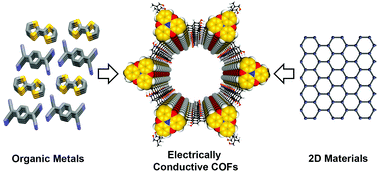Electrically conductive covalent organic frameworks: bridging the fields of organic metals and 2D materials
Abstract
The discovery of organic metals in the 1970s opened the door to the design of electrical devices based on traditionally inert (insulating) organic materials. More recently, demonstration of record-high charge mobility and unusual electronic structure (e.g. Dirac cones) in graphene have given rise to an entire new field of two-dimensional (2D) materials. In this direction, covalent organic frameworks (COFs) have emerged as promising 2D materials for organic electronics due to their immense structural diversity and electronic properties tuneable by chemical design. Although the electrical conductivity of most reported COFs is still too low for many practical applications, several promising strategies have been proposed in the past few years to enhance the electronic transport in these materials. Here, we discuss the recent advances and main approaches towards the design of conductive COFs, highlight some of the challenges in such design and give our views on the future directions of this field.

- This article is part of the themed collections: 2021 Journal of Materials Chemistry C most popular articles and Materials for molecular electronics and magnetism


 Please wait while we load your content...
Please wait while we load your content...